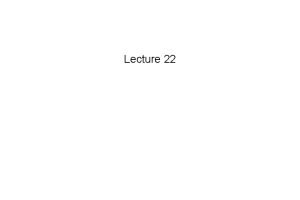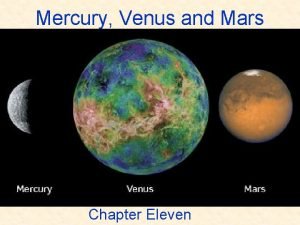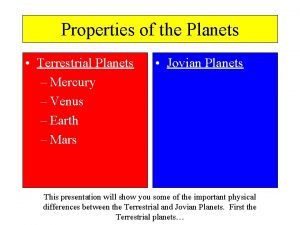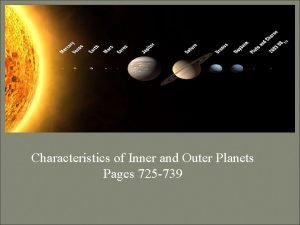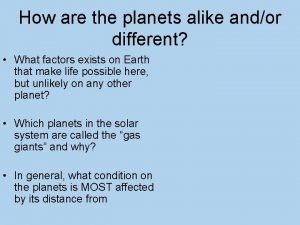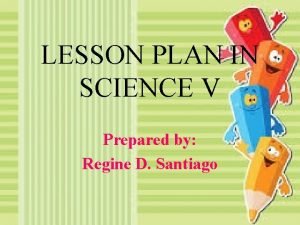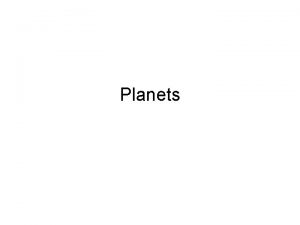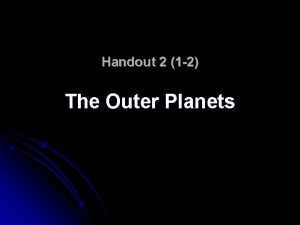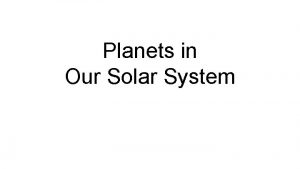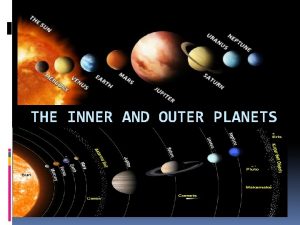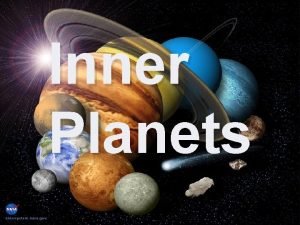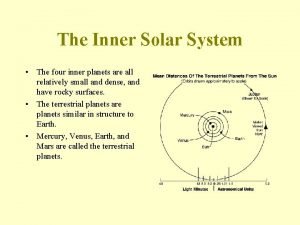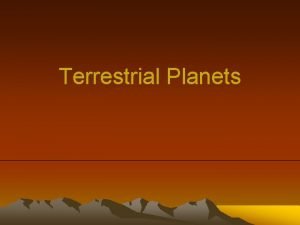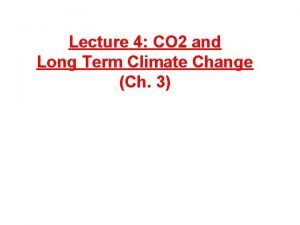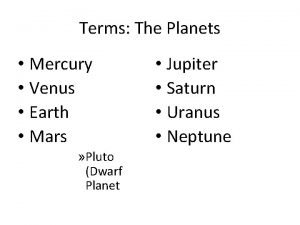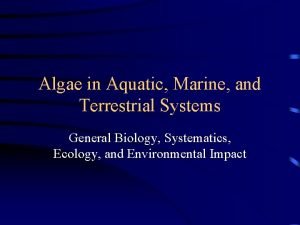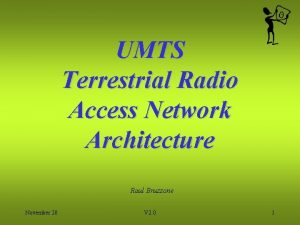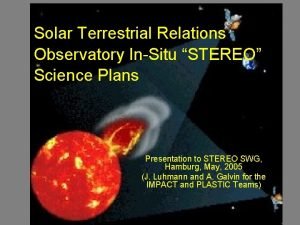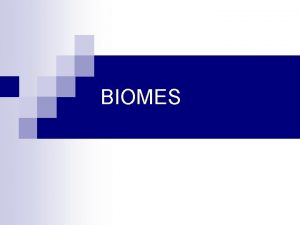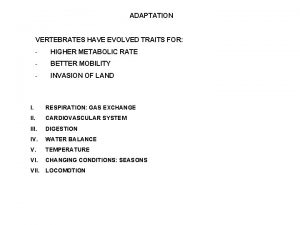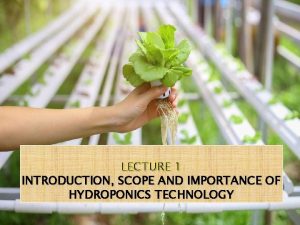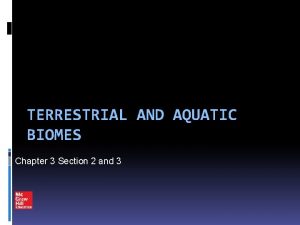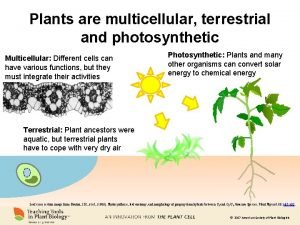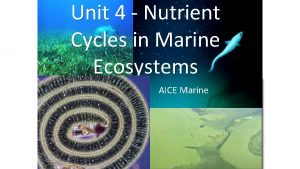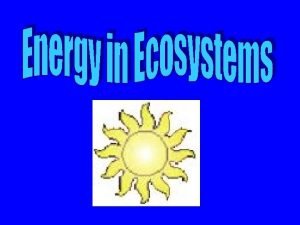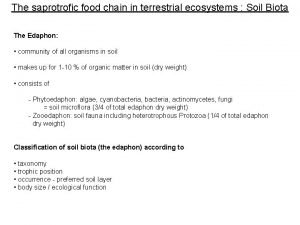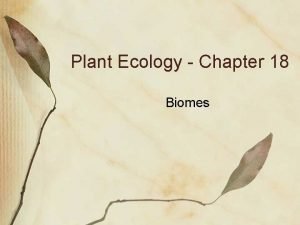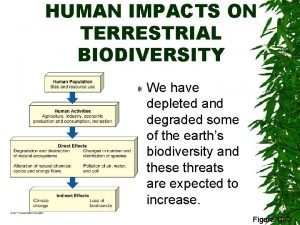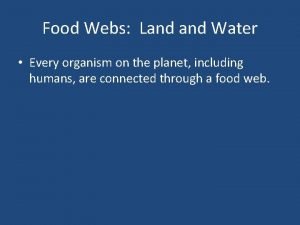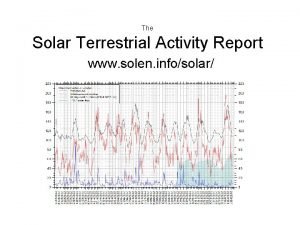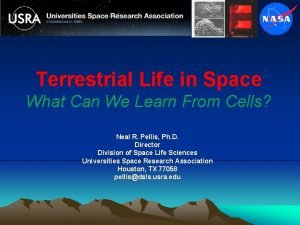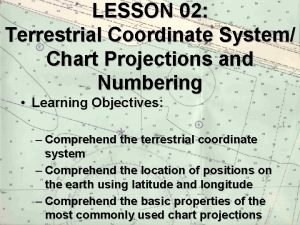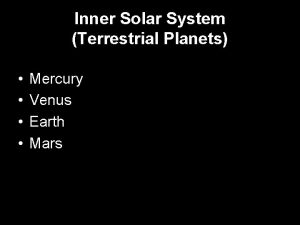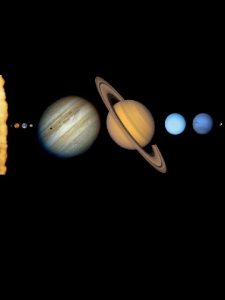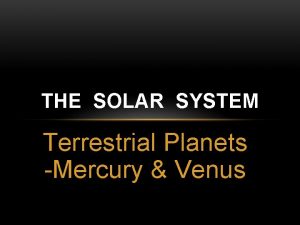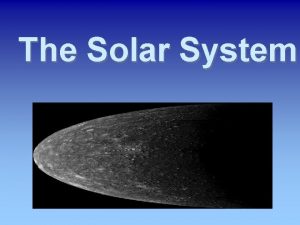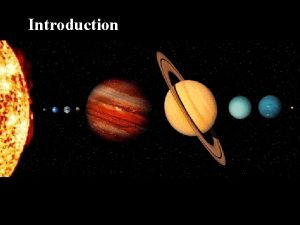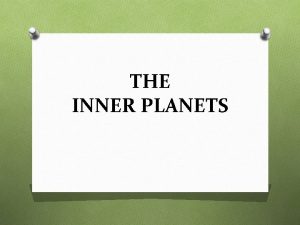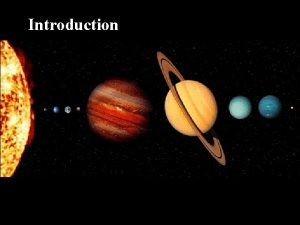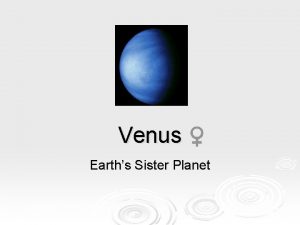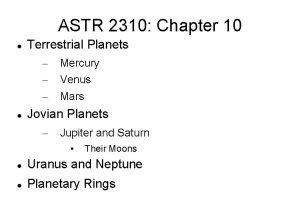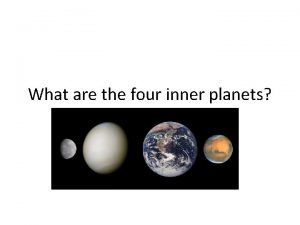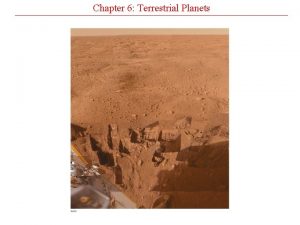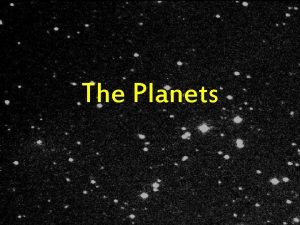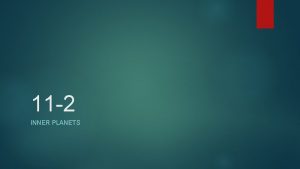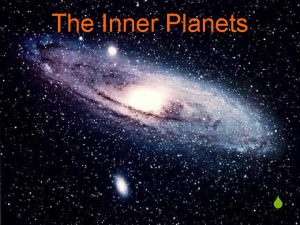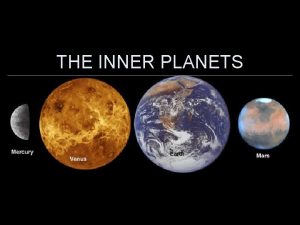The Inner Planets Terrestrial Planets Mercury Venus Earth

































































- Slides: 65

The Inner Planets “Terrestrial” Planets • • Mercury Venus Earth Mars

Mercury

Mercury’s surface looks like our moon

Venus

Venus’ surface seen from Russia’s Venera spacecraft

Mars









Olympus Mons


Moons of Mars

The Asteroid Belt Between Inner and Outer Planets



So Pluto is no longer considered to be a planet. Why is that? What IS a planet anyway? ? ?

The International Astronomy Union came up with THREE classes of objects that orbit the sun: • Planets • Dwarf Planets • Small solar system objects

Planets • Orbit the sun • Are round (because their gravity pulls them into that shape • Are big enough and have enough gravity to “clear the neighborhood” around their orbit

Dwarf Planets • Orbit the sun • Are round • Are not moons of another planet (they only orbit the sun) • Are not big enough to “clear their neighborhood”

Small Solar System Bodies Everything else: comets asteroids meteors

The Kuiper Belt (beyond Neptune) 9. 3 billion miles from our sun… contains at least 70, 000 objects, including Pluto, Eris, Haumea, and Makemake. (Called KBO’s)

The Oort Cloud Huge swarm of small icy objects orbiting the sun at a distance of 1, 000 to 50, 000 AU from the sun (almost halfway to Proxima Centauri!)

Meteor A streak of light made when a small piece of rock plunges into Earth’s atmosphere and glows from the heat of friction.

Meteorite A piece of space debris that reaches the earth’s surface without burning up.

Meteoroid A small rocky body traveling through space (Basically a small asteroid!)

Asteroid A large, irregular rocky object that orbits the sun – Too small to be a planet




Comet A mountain-sized “dirty snowball” made of rock and ice in orbit around the sun


Jupiter – King of the Planets


Jupiter’s “Galilean” Moons


Jupiter and Its Largest Moons


Io











Mimas

Short video of Jupiter and Saturn http: //www. youtube. com/watch? v=e 8_l. Sgn_g. Tk




Uranus’ Moons


Neptune has a big blue spot like Jupiter’s Red Spot!

Triton

Pluto’s tilted orbit


Pluto and Its Moons
 What are jovian planets made of
What are jovian planets made of Inner planets and outer planets
Inner planets and outer planets What separates the inner planets and outer planets
What separates the inner planets and outer planets The inner solar system by leslie
The inner solar system by leslie Inner defender and inner guide examples
Inner defender and inner guide examples Is venus terrestrial or gaseous
Is venus terrestrial or gaseous Mercury venus
Mercury venus Mercury planet
Mercury planet Surface of terrestrial planets
Surface of terrestrial planets Characteristics of outer planets
Characteristics of outer planets Mass of terrestrial planets
Mass of terrestrial planets Characteristics of the inner planets
Characteristics of the inner planets Are all outer planets gas giants
Are all outer planets gas giants How are the inner and outer planets alike
How are the inner and outer planets alike Inner outer planets venn diagram
Inner outer planets venn diagram Planets groups
Planets groups Matching planet rings
Matching planet rings Inner planets
Inner planets What separates the inner and outer planets
What separates the inner and outer planets Inner planets
Inner planets What are the four inner planets
What are the four inner planets Smallest terrestrial planet
Smallest terrestrial planet Inner critic and inner defender
Inner critic and inner defender Venus vs earth
Venus vs earth Pluto planta
Pluto planta Terrestrial only
Terrestrial only Are protists terrestrial or aquatic
Are protists terrestrial or aquatic Wcdma network architecture
Wcdma network architecture Human impact on terrestrial ecosystems
Human impact on terrestrial ecosystems Example of terrestrial biome
Example of terrestrial biome Terrestrial animals
Terrestrial animals Solar terrestrial relations observatory
Solar terrestrial relations observatory Freshwater food web
Freshwater food web Are bacteria autotrophs or heterotrophs
Are bacteria autotrophs or heterotrophs Respiration in terrestrial animals
Respiration in terrestrial animals Importance of hydroponics
Importance of hydroponics Biomes summary chart
Biomes summary chart Chapter 3 section 2 terrestrial biomes
Chapter 3 section 2 terrestrial biomes Photosynthetic multicellular and terrestrial
Photosynthetic multicellular and terrestrial Nutrient cycles in marine ecosystems
Nutrient cycles in marine ecosystems Gymnosperms
Gymnosperms A series of events in which one organism eats another
A series of events in which one organism eats another Hlistice
Hlistice Aquatic vs terrestrial
Aquatic vs terrestrial Navigation terrestrial
Navigation terrestrial What are biomes defined by
What are biomes defined by Impacts of wildlife trade on terrestrial biodiversity
Impacts of wildlife trade on terrestrial biodiversity Terrestrial habitat
Terrestrial habitat Food chain of land
Food chain of land Terrestrial food web
Terrestrial food web Solen.info
Solen.info Terrestrial life
Terrestrial life Terrestrial food production
Terrestrial food production Terrestrial coordinate system
Terrestrial coordinate system Terrestrial soil
Terrestrial soil Sơ đồ cơ thể người
Sơ đồ cơ thể người Tư thế ngồi viết
Tư thế ngồi viết đặc điểm cơ thể của người tối cổ
đặc điểm cơ thể của người tối cổ Cái miệng bé xinh thế chỉ nói điều hay thôi
Cái miệng bé xinh thế chỉ nói điều hay thôi Mật thư anh em như thể tay chân
Mật thư anh em như thể tay chân Chụp phim tư thế worms-breton
Chụp phim tư thế worms-breton Bổ thể
Bổ thể ưu thế lai là gì
ưu thế lai là gì Tư thế ngồi viết
Tư thế ngồi viết Thẻ vin
Thẻ vin Thơ thất ngôn tứ tuyệt đường luật
Thơ thất ngôn tứ tuyệt đường luật






